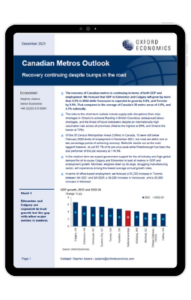Canadian recovery continuing despite bumps in the road

The recovery of Canadian metros is continuing in terms of both GDP and employment. We forecast that GDP in Edmonton and Calgary will grow by more than 5.5% in 2022 while Vancouver is expected to grow by 5.4%, and Toronto by 5.0%. That compares to the average of Canada’s 35 metro areas of 4.8%, and 4.3% nationally..
What you will learn:
- The risks to this short-term outlook include supply-side disruptions (from chip-shortages in Ontario to extreme flooding in British Columbia), widespread labour shortages, and the threat of future lockdowns despite an internationally-high vaccination rate across all provinces (Alberta the highest at 86%, and Ontario the lowest at 72%).
- Of the 35 Census Metropolitan Areas (CMAs) in Canada, 10 were still below February 2020 levels of employment in November 2021, but most are within one or two percentage points of achieving recovery. Belleville stands out as the main laggard however, at just 83.7% of its pre-virus peak while Peterborough has been the star performer of this job recovery at 114.3%.
- In the medium term we expect government support for the oil industry and high global demand for oil to cause Calgary and Edmonton to lead all metros in GDP and employment growth. Montreal, weighed down by its large, struggling manufacturing sector, will experience among the lowest average annual growth rates.
Tags:
Related Services

Post
Food prices to bottom out in 2024, risks skewed to upside
Our baseline forecast is for world food commodity prices to register an annual decline this year, in aggregate, reducing pressure on food retail prices further downstream. However, we believe the risks to this forecast are overwhelmingly skewed to the upside.
Find Out More
Post
Battery raw material prices to recover
Battery raw materials prices bottomed out last quarter and we think a sustained recovery is looming. Midstream EV battery manufacturing activity has picked up again and inventories have returned to historical levels, suggesting upstream demand for raw materials will also bounce back.
Find Out More